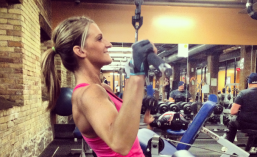When I first started noticing symptoms of asthma it was spring 2013, and I was training for a fitness show. Training six days a week, extra cardio, and certain days I would train twice in one day, my body was at peak performance. However, something was holding me back.
As I trained harder and implemented more cardio and plyometrics to my workout routine I found myself gasping for air, chest tightening, and unable to take in full breaths. At night lying in bed I could barely breathe. What could possibly be wrong? My body was getting properly taken care of with exercise, clean eating, vitamins, and rest, but something was taking over my body that I was not prepared for.
*Back track to a year prior I was training at Acceleration Sports Training Center in Grand Rapids Michigan. There I trained athletes of all ages and sports. We specialized in athletic performance enhancement training programs. Specific training protocols and specifically designed exercises to enhance athletic performance. It was here that I noticed a trend of bad seasonal allergies and sinus pressure. I would have so much pressure in my ear (sphenoid cavity), that I could hear myself talking and breathing. My breathing was difficult due to the (maxillary cavity); it was hard to take a full breath in when running on the treadmill doing specific protocols with my former boss (Chris Davis). It slowed me down considerably. I knew I wasn’t a strong runner and that aerobic exercise wasn’t my forte, but I knew this couldn’t be normal.
With all of the right that I thought I was doing to my body, the wrong was happening to my health. Not being able to perform to my best performance while training for a show was not only difficult but a major setback and concern for my own well being. At night I couldn’t take a full breath while lying in bed, and that’s when I knew I had to go see a doctor immediately. A few days later I went and spoke with a doctor where she checked my vitals, and breathing, where I expressed my concerns. The doctor prescribed me to two inhalers, and allergy medication. It seemed to help reduce my symptoms, and allow me take in full breaths and train longer. I now train to ensure I get a good cardio in that is based on my limitations. I have good days and bad days depending on the pollen count and air pollution and also the humidity outside. Although exercise induced asthma has taken control of my workouts, I now have a better understanding of how to control it.
- If you think you have exercise induced asthma contact your doctor today and get on track to being able to do the things you enjoy.
Some signs and symptoms of Exercise Induced Asthma include:
What is EIA?
eMedicineHealth defines EIA as:
Asthma is a chronic inflammation of the breathing passages (bronchi) of the lungs. Asthma is characterized by sudden attacks or periods of bothersome or severe symptoms separated by periods of mild symptoms, or no symptoms at all. The inflammatory reaction of asthma is triggered by external factors or specific situations. When a person with asthma is exposed to one of his or her triggers, the inflammation worsens and symptoms begin.
- Triggers include contaminants in the air, such as smoke, pollution, vapors, dust, or other particles; respiratory infections, such as colds and flu (viruses); allergens in the air, such as molds, animal dander, and pollen; extremes of temperature or humidity; and emotional stress.
Exercise is a common trigger of asthma attacks
- Exercise can even induce an asthma attack in people who have no other triggers and do not experience asthma under any other circumstances.
- People with exercise-induced asthma are believed to be more sensitive to changes in the temperature and humidity of the air.
- When you are at rest, you breathe through your nose, which serves to warm, humidify, and cleanse the air you inhale to make it more like the air in the lungs.
- When you are exercising, you breathe through your mouth, and the air that hits your lungs is colder and drier. The contrast between the warm air in the lungs and the cold inhaled air or the dry inhaled air and moist air in the lungs, can trigger an attack.
Once the attack is triggered, the airways begin to swell (broncho-spasm) and secrete large amounts of mucus.
- The swelling and extra mucus partially block or obstruct the airways. This makes it more difficult to push air out of your lungs (exhale).
- When asthma is left untreated and the inflammation persists, permanent narrowing of the airways can occur. If this happens, this chronic asthma can also be referred to as chronic obstructive pulmonary disease(COPD), like emphysema and chronic bronchitis.
For some forms of asthma, it is important that chronic maintenance medications are used to prevent the development of COPD. Asthma cannot be cured, but it can be controlled by medication. Fortunately, in those with only exercise-induced asthma (EIA), maintenance therapy is often not required and medication can simply be taken before exercise.
- With appropriate treatment, almost everyone with EIA can enjoy the mental and physical benefits of regular exercise.
- The large number of elite athletes who have asthma attests to the effectiveness of asthma medication.
- Whether you walk around your neighborhood or run marathons, asthma doesn’t need to stop you from reaching your exercise goals.
